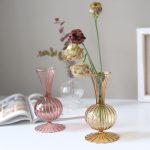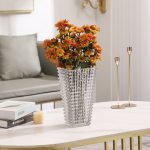Introduction to Flower Frog Vases
Flower frog vases are a staple in the world of floral design. These unique vases are not only practical but also elegantly showcase flowers. The term ‘flower frog’ refers to an insert that fits inside a vase. It holds each stem in place. This allows for precise arrangement and optimum water intake for the blooms. Flower frog vases come in various shapes, sizes, and materials. Each type serves a specific purpose. Some are ideal for single, delicate flowers, while others can hold lush, heavy bouquets.
Their popularity stems from their versatility and functionality. With a flower frog vase, arranging flowers is no longer a messy task. This tool ensures a clean process and also extends the life of the flowers. Using a flower frog vase transforms floral arrangements into art. It gives you the control to position each stem at just the right angle. The result is a professional-looking bouquet every time.
Whether you are a seasoned florist or an amateur enthusiast, a flower frog vase is an essential. It will elevate the look of any floral arrangement. In the coming sections, we’ll delve deeper into the history, types, and trends of flower frog vases. We will provide tips on selecting and caring for them. Get ready to unlock the full potential of your blooms with these amazing floral tools!
The History of Flower Frog Vases
The journey of flower frog vases began in Japan. Here, they were part of the ancient art of Ikebana. This form of floral arrangement dates back to the 7th century. The traditional Japanese flower frogs are known as ‘kenzan’. They feature a heavy lead base spiked with brass needles. The purpose was to hold flowers in place for precise and thoughtful arrangements.
The concept of flower frog vases spread to the West in the early 20th century. They gained popularity as the art of floral decoration flourished. In America and Europe, the designs evolved. Manufacturers used various materials like glass, ceramic, and metal. They created many shapes to suit different vase sizes and flower types.
During the 1920s and 1930s, the use of flower frogs peaked. They were commonplace in households. Many saw them as indispensable for proper table setting. Flower frog vases were not just functional. They were often intricate and beautiful, doubling as decorative pieces.
However, their widespread use declined after the invention of floral foam in the 1950s. This new product allowed for easier arrangements without a flower frog. Despite this dip in popularity, flower frog vases remained beloved by enthusiasts and professional florists.
Today, there is a resurgence in their popularity. This is due to a greater appreciation for sustainable and classic floral arrangement methods. Flower frog vases are making a comeback as people rediscover their practicality and beauty. They are a blend of tradition and modern design, bringing timeless elegance to flower displays.
Types of Flower Frogs and Their Uses
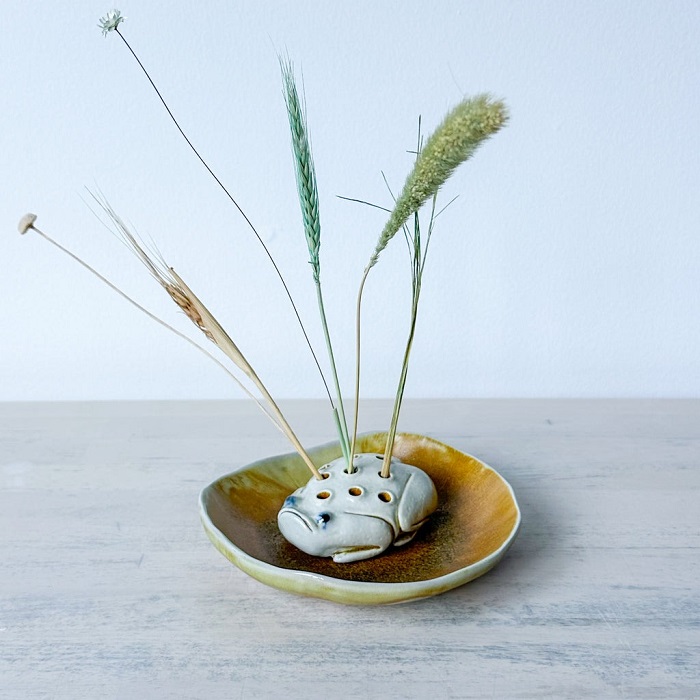
In the world of floral arrangement, diversity is key. Understanding the different types of flower frogs can help craft spectacular displays. Let’s explore the main varieties and their roles in creating beautiful bouquets.
Pin Frog: The pin frog matches the description of the traditional Japanese ‘kenzan’. It is a heavy base with upright pins where flowers are impaled to stand. This type is great for thick-stemmed flowers.
Glass Flower Frog: Glass options come in various shapes, like dome or flat. They blend well with glass vases for a seamless look. They’re ideal for delicate flowers and allow clear viewing of the stems underwater.
Ceramic Flower Frogs: These are decorative and often collectible. They fit well in opaque vases and support a wide range of flowers. Their hefty weight makes them suitable for heavier, more elaborate arrangements.
Wire Mesh Flower Frogs: These frogs are less rigid, hence more forgiving. They are excellent for beginners. You can bend and shape them to hold flowers in specific positions without damaging stems.
Suction Cup Flower Frogs: They attach firmly to the vase’s base with a suction cup. They are perfect for intricate designs where flowers must stay in place without shifting.
Each type of flower frog vase serves a unique purpose. The choice depends on the style and structure of your floral arrangement. By selecting the right flower frog, you can ensure that your flowers get the support they need. In turn, they will look as fresh and stunning as possible, lasting longer for you to enjoy.
How to Select the Right Flower Frog Vase for Your Blooms
Selecting the right flower frog vase for your blooms is essential for creating eye-catching displays. Here are key tips to consider when making your choice:
Assess Your Flower Type: Look at your flowers’ stem type and size. Thick stems need sturdy support like a pin frog. Delicate stems do better with glass or wire mesh frogs.
Consider Vase Compatibility: The flower frog should fit snugly in your vase. Make sure the diameter and depth match, so the arrangement stays stable.
Look for Quality Materials: A durable flower frog vase can last a long time. Choose high-quality materials like solid metal, glass, or ceramic based on your needs.
Think About the Arrangement Size: Plan for the size of your floral designs. Larger arrangements may require a heavier and more elaborate flower frog.
Visual Appeal Matters: If your vase is transparent, a glass frog can complement the look. Opaque vases pair well with ceramic frogs as they remain hidden.
Ease of Use: Beginners should opt for wire mesh frogs which are versatile and easy to use. Experts might prefer pin frogs for complex arrangements.
By taking these factors into account, you can assure your flowers will stand out beautifully. A mindful selection of a flower frog vase not only elevates the arrangement’s look but also contributes to the longevity of your blooms. Be sure to choose one that not only serves its purpose well but also suits your personal style and the aesthetics of your living space.
Creative Ways to Arrange Flowers with a Frog Vase
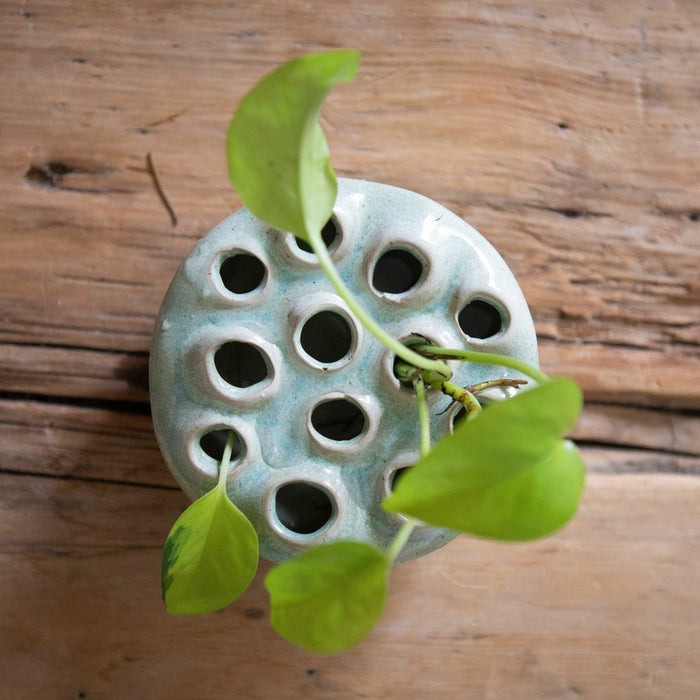
Unleash your creativity with a flower frog vase as your ally. Here are some ideas to inspire your flower arranging skills:
Start With a Theme: Pick a color, season, or occasion to guide your choice of blooms. This helps create a cohesive look.
Mix Textures: Combine soft petals with spiky grasses or glossy leaves. Textures add depth to your display.
Play With Heights: Place taller stems in the center or back. Arrange shorter blooms in front. This creates a dynamic, layered effect.
Focus on Balance: Aim for symmetry or an asymmetrical design. Both can be striking. Ensure that your flowers look balanced in the vase.
Add Unexpected Elements: Try adding fruits or branches. These can bring a unique twist to your arrangement.
Use a Grid: If your frog vase is wide, lay out a grid with tape. This helps organize where to place each stem.
By experimenting with these tips, you can craft stunning arrangements. Flower frog vases offer a world of possibilities. They allow precision and playfulness in floral design. With practice, you’ll become adept at showcasing your blooms in fresh and exciting ways.
Maintenance and Care for Your Flower Frog Vase
Maintaining your flower frog vase is crucial for longevity. Here are straightforward tips to preserve your vase:
Clean Regularly: After use, remove all floral matter. Wash the vase with warm, soapy water. Rinse it thoroughly.
Handle with Care: Flower frog vases, especially glass or ceramic, can be fragile. Handle them gently to avoid chips or cracks.
Dry Completely: Before storage, ensure your flower frog vase is completely dry. This prevents mold or rust.
Store Safely: Keep your vase in a padded area if it’s glass or ceramic. Secure metal frog bases to prevent oxidation.
Check for Sharp Edges: For pin frogs, make sure pins remain blunt. Sharp edges can harm flowers or cause injuries.
Avoid Harsh Chemicals: Do not use abrasive cleaners. They can damage your flower frog vase over time.
By following these care steps, your flower frog vase will stay in prime condition. It will be ready for your next floral masterpiece.
The Role of Flower Frog Vases in Modern Floral Design
Flower frog vases not only bring tradition to modern floral design, they’re also key to innovation. As eco-conscious practices gain momentum, these tools stand out for sustainability. They’re reusable, unlike single-use floral foam. This is a major plus for designers who value eco-friendly methods.
These vases offer flexibility, letting florists manipulate flower placement with precision. Their resurgence has encouraged florists to explore new design frameworks. Without relying on floral foam, flower frog vases challenge designers to think about structure and balance differently.
Today’s flower frogs are also adapting to contemporary aesthetics. They’re not just functional; they’re fashion statements in the world of decor. Modern floral artists use them in minimalist designs as well as elaborate setups. They are an essential part of the creative process, allowing for unique expression through flowers.
The integration of flower frog vases in modern floral design has also led to educational workshops. These workshops teach amateurs the art of arrangement with these tools. It’s a nod to the vases’ historical significance while celebrating current design trends.
Flower frog vases, though rooted in history, have proven to be timeless. They embody the blending of past and present and pave the way for future floral artistry.
Popular Flower Frog Vase Styles and Trends
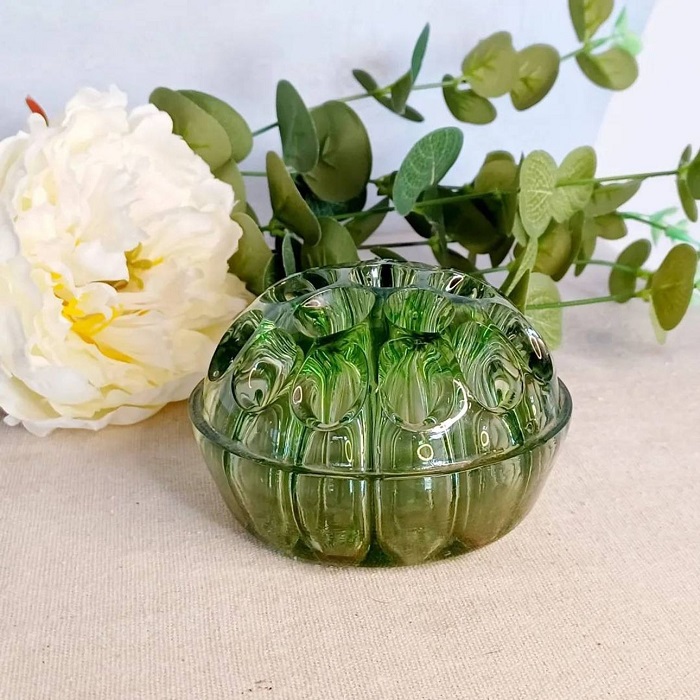
When we talk about flower frog vases, knowing the latest styles and trends is key. This knowledge keeps your arrangements fresh and exciting. Here are the top trends shaping flower frog vase use today:
Return to Vintage: Vintage styles are back in vogue. People love the charm of old-fashioned glass or ceramic flower frogs. They add a touch of history to modern homes.
Minimalist Designs: Simple, sleek vases with a single frog are trending. They fit well in any space without overwhelming it. The focus remains on the flowers.
Bold Colors: While traditional flower frogs were more subdued, today’s options explore vibrant colors. These add a pop of personality to your floral display.
Multi-Purpose Frogs: Frogs that double as decorative pieces when not in use are popular. They serve both utility and aesthetics, and people appreciate that.
Environmentally Friendly Materials: As we become more eco-aware, there’s a push for sustainable materials. Metal and glass frogs are preferred over plastic versions.
Integration with Art: Flower frogs are not just for flowers anymore. They’re being incorporated into larger art pieces for a striking effect.
By staying updated with these trends, you can ensure your flower displays capture attention. Choose a flower frog vase that speaks to current styles but also suits your personal taste.
